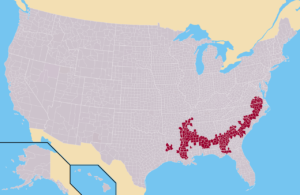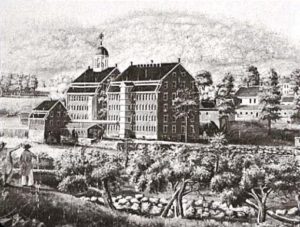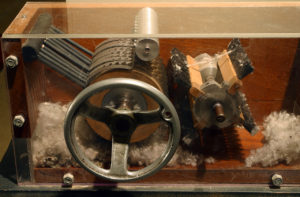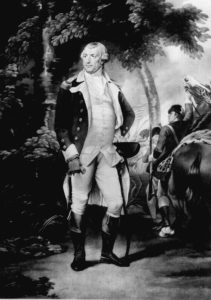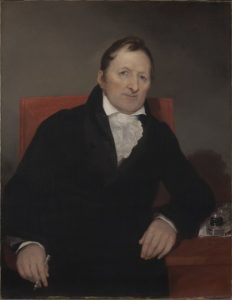Comparing different regions reveals critical realities that affected the course of American ED. After 1789 (1) the North, led by Yankees and Midlanders, embraced the industrial revolution; the West, outside then-current American Republic, unsettled by Europeans did not seriously commence development until the Civil War period; and (3) the South embraced an agricultural innovation, a new crop, deemphasizing, industrialization and urbanization, and continuing the society, politics and economy of the late-medieval/pre-industrial England.
Module Mini-Series (3A) dwells on the last: the rise of the South’s Cotton Belt. Mini-Series A offers four modules, intended to be read sequentially, but each standing on its own.
- The first module, this one, introduces cotton as a global dynamic and an innovative agricultural platform commodity. Cotton was more than a crop. It transformed the South, created the so-called Deep South with its own distinctive political culture, society, economics and politics and led the nation down a path to the Civil War. Whatever else it did, cotton profoundly shaped the evolution of American State and Local ED.
- The second module in Mini-Series A details the initial appearance of cotton in the Upcountries of South Carolina (1794). The South Carolina Upcountries were the “womb” of the Cotton Belt, and in many ways are a microcosm of the political culture and politics that would eventually produce a distinctive ED that spread across the entire Deep South. Its heritage persists to the present.
- The third Mini-Series A module outlines the diffusion of the Cotton Belt after 1815, and a chronicle of its dynamics through the Deep South until 1860.
- The fourth, and final Mini-Series A module focuses on Alabama, our “First Notch in the Cotton Belt”. The Alabama case study permits a more intensive look at what many have called the “deference culture” that supposedly characterized the Deep South. Our rendition of this deference culture is quite different than than posited today; I believe it more accurately describes the Alabama state policy system and its distinctive approach to MED.
Cotton: the “Last Hurrah” and an “Agricultural Platform Innovation”
Why agriculture not industrialization? Why did the South follow an agricultural path, not only in 1789, but doubled-down on it after 1865–despite having lost the War, in large measure because it had not industrialized?
The bottom-line answer revolves around the South’s distinctive patterns of migration and political culture that was reflected in southern 19th Century policy systems. The South and the North, as explained in the last module, had engaged in America’s “First Big Sort” during the Colonial Era. The migration/culture flows distinguished each from the other, and separated them economically, politically, and socially. Despite this divergence they had come together to form a United States. But during this Early Republic/Antebellum South they were never “united” in their economic systems, and did not practice identical strategies or programs in pursuit of common economic development goals.
Some, like Sven Beckert (Empire of Cotton, 2014) believe cotton played a critical role in “the great divergence” that over the 19th century produced today’s “north and south” global economies. It was a major element of Rostow’s “take off” or break out that left the developing Third and Fourth Worlds in its dust. Also textile manufacturing was the “breakout sector” in the English Industrial Revolution after 1780.
Unlike [sugar, rice, tobacco, rubber, and indigo] cotton has two labor-intensive stages–one in the fields and the other in the factories. Sugar and tobacco did not create large industrial proletariat in Europe. Cotton did. Tobacco did not result in the rise of vast new manufacturing enterprises. Cotton did. Indigo growing did not create huge new markets for European manufacturers. Cotton did. Rice cultivation in the America’s did not lead to both slavery and wage labor. Cotton did…. [1].
Timing, and the factor that cotton was not a consumable food, but rather rather raw material for a top-priority need of nearly every living person on the planet, was what cotton possessed that other commodities didn’t. But then the question is “Why the American South”?
Two reasons to start out with: immense acres of land, and a population grouping that seized upon its seemingly unlimited future as a path to personal success through cotton entrepreneurialism. The South as we have seen exhibited its own distinctive immigration/migration pattern that departed significantly from the North’s. Tidewater English, a Scots-Irish border immigrant mélange, and a Deep South Barbadian political culture congealed around an 1800 agricultural innovation (cotton and the cotton gin)–and an agricultural economy, that overshadowed the industrial path evolving in the North. Agriculture, and the way-of-life it sustained, was rooted in the values cherished by the South’s political cultures. As an aggregate they valued tradition, and experience of past generations–experience shaped by agriculture and medieval society.
That guided their image of the future, which they envisioned as either a small-scale yeoman farmer republican democracy, or a “new”, transformed manor-agricultural unit (its primary EDO in our lexicon): the slave mass-production plantation engaged in a highly competitive global competition. In 1800 the plantation, as evil as it was, as ancient as it was, was intended to be the South’s answer to the demands of the northern industrial factory. The South, BTW, never rejected industrialization in toto, rather, southerners were both skeptical of it and regarded it of secondary importance. Important industrial sectors (railroads and machinery) were redirected to serve mostly agricultural ends.
Cotton as a crop was far from “new”, but technological innovation, European colonization, and incipient European industrial capitalism came together in a perfect storm to fuel new gazelle-sector(s) suitable for multiple geographies, with an incredibly expanding global market. From the late 18th Century onward, this agricultural sector, colonization, and European industrial capitalism triggered explosive, profitable, and dynamic economic growth. From the late 18th Century through much of the 19th,”the “lords of the lash“, and the “lords of the loom” were “tightly linked” [2] in a transition age from agriculture to industry. The timing of the cotton innovation could not have been better.
Cotton diffused during the transition from agriculture to an industrial age. It is in this sense I think of it as “the agricultural revolution’s last hurrah”.
the Cotton (and Black) Belt
That growth led to the rise of the American Cotton (Black) Belt–the geographic nexus that was the cutting edge of the antebellum South–and the foundation of the South’s economic development path. If northern entrepreneurism embraced manufacturing, the industrial shop and mass-production textile-producing factory, the antebellum South adopted the plantation economy symbiotic with the homestead, yeoman farmer economy. The cotton migration that followed, and the cultural-political-societal nexus that resulted, preferenced tradition, stability with extreme inequality, rural isolation, distrustful of change and industrial-age innovation, and the new relationships, institutions, and values they implied. The path they chose minimized industrialization’s place, but did not reject or exclude it. Cotton was the last major crop/commodity previous to the “victory” of a new industrial/finance capitalism.
On the contrary. Without the participation of, and reliance on, the “lords of the looms”, new forms of transportation logistics, finance/investment, scientific crop experimentation, agricultural machinery, and a highly competitive global hierarchy, the agricultural path would surely fail. Like it or not, if only because they were resident in an American nation whose northern residents had embarked on a semi-industrial path, the South’s-Cotton Belt’s economic base was always a hybrid agricultural-industrial base. That necessarily created a tension, later labeled the “divided mind”, that was central to their antebellum policy systems.
But our concern at this point is more basic: why did the South pursue a primarily agricultural, not industrial, economic base. That decision, I believe, principally centered on the perceived allure and opportunity of cotton, “the white-gold“, its multi-faceted, transformative “platform” that instilled a sense of mission and momentum as a gazelle-sector that revolutionized agriculture by inserting it into global markets creating a seemingly insatiable demand that could be met only by mass production financed by industrial age finance capitalism.
As unpolitically correct it may be to say, cotton opened up new ways to achieve a southern, Early Republic-agricultural American Dream. It offered wonderful opportunities for the different classes (not African-American slaves on whose backs this system rested) and ethnic cultures, including a cotton version of hardscrabble homesteading that stabilized yeoman agriculture and offered a path satisfying middle-class aspirations. It also made its planter class the richest grouping in the United States at that time, and plantation-dominated geographies the most affluent counties in America. Cotton, for better and worse, mostly lived up to its promises during the antebellum South.
Rightfully detested today, slavery and unionized worker suppression were a perceived necessary prerequisite for the cotton platform innovation to be successful. Mass production in these years, they believed meant slavery, legitimized by racism, as it was the cheapest mass labor force possible in early industrial age developed world. Given volatile cotton prices, it was the only labor force that could be maintained in recessionary times. It was the only labor force that would endure a hostile climate, and live in primitive subsistence households.
That inhumane insensitivity, that inherent racism which legitimized it, similar to the congruent Boer migrations of South Africa, planted the seeds for its failure and defeat. As the Last Hurrah of the Agricultural Revolution, it was terminally out-of-step in the Industrial Age; in my view a 1000 year regression to the late-Empire latifundia of a declining Rome.
Timing is Everything?
The path taken by the South after the cotton gin, certainly its economic development path, would almost certainly have been radically different without cotton–and the role it played as “platform crop”, the last hurrah of the Agricultural Revolution. Said and done, the Deep South cotton plantation was its core economic development organization (EDO), and around that EDO a society, policy system, and an economic base was constructed.
The Plantation, a modernized, globalized Roman latifundia, arguably developed in Portuguese colonial Brazil to produce sugar cane. That is what the Barbadian planters grew, and as explained in the last module, it was the form of plantation imported by Barbadians into South Carolina. English Tidewater planters grew tobacco. The plantation developed by these Royalist Tidewater elites, although seemingly similar in its core structures, was not the form of plantations (and slavery) that spread across the Deep South. This module concentrates solely on the Deep South policy system and its distinctive agricultural economic base ruled by King Cotton.
Cotton plantations were the “new” agricultural production units, agricultural startup gazelles, in an economic base dominated by agriculture and farming. As it developed the cotton nexus coexisted with a new “Age” industrial economy that was in its early years. As cotton diffused across the globe, generating serious wealth-creation capacity, it also dove-tailed cotton into this “industrial” economy that was similarly gathering steam (pardon the pun). Cotton fed into the first major industrial sector of the new industrial age: the textile industry. Cotton and textile production were “hand and glove” through the antebellum South described in this theme. The Belt diffused into Alabama after 1815. Lowell Massachusetts textile mills were built starting in 1816.
The cotton plantation was the agricultural factory that both created mass demand for the product, and satisfied it, simultaneously fostering a manufacturing-finance-transportation industry-sector nexus to sustain it, and the policy systems that supported and legitimized them. It is this sense that I call this a “agricultural platform innovation”, similar to a platform technology such as the combustion engine, computer chip and micro-processor), or the Internet.
Cotton, the nineteenth century’s chief global commodity brought seeming opposites together, turning them, almost by alchemy into wealth: slavery and free labor, states and markets, colonialism and free trade, industrialization and deindustrialization. The cotton empire depended on plantation and factory [mass production], slavery and wage labor, colonizers and colonized, railroads and steamships–in short on a global network of land, labor, transport, manufacture and sale [to this I also add finance][3].
So, in summary, the “innovation” was not cotton itself, which had been around literally several thousand years; it was the 1793-4 cotton gin that allowed American cotton to separate seed from the cotton ball. The opportunity was the weaknesses of existing plantation commodities, and the incredible timing of the cotton gin with the coming on line of British textile mills. The two combined the ability to harvest volumes of American cotton and make it available to textile mills using logistical innovations to produce textiles to satisfy potential demand from a global population. Naturally, investment capital followed.
By 1790 things weren’t looking so good for plantation economics. Virginia’s Jefferson was always broke and in debt; frequently blamed for his excesses, expenditures and life style but the core issue was that he and other Tidewater tobacco planters faced was soil depletion, the crippling deficiencies of the plantation business model, and matured market demand. Likewise, Indigo planters discovered markets demand had its limits–and so must its production. Rice, primarily sold to domestic markets, suffered from competition with other crops (wheat), and was severely limited to wetland coastal lowlands. None of these crops, therefore, were transformative or platform crops. Solid staples to be sure, but gazelles no longer–the profit-life-cycle plays out in agriculture as well as it does in manufacturing, and technology. Cotton proved to be the gazelle–the platform crop. Also, it was the savior for a declining plantation system.
Cotton and the Innovation
Cotton was an ancient crop, a secondary crop planted alongside food crops mostly by women, and used to make clothes and such. By 1000 AD, cotton along with linen (from the flax plant), silk, jute and hemp (depending on where one lived) had, in effect, become an early manufacturing “industry”. Found across the globe; cotton is more tolerant of climate, or even soils, compared to other crops. The South then, or now, holds no natural geographic monopoly. Global competition was evident from the start; southern cotton plantations coexisted with cotton produced in Egypt, India, China and elsewhere.
First, some background. A cotton plant produces a ball which is picked; the plant is not harvested like wheat. If the ball is separated from the plant, the plant can grow yet another ball in the same season. Obviously that makes it more profitable and suitable to a climate with a long-growing season. That, however, made harvesting complicated; it had to be hand “picked”. The cotton gin did not address that problem. Slavery did. A second problem is that once picked, the cotton ball included a seed network that had to be culled from the ball. This also had to be done ball by hand, by somebody–it was an incredibly tedious, finger-numbing, and horribly time-consuming task that grossly limited production volume. The cotton gin separated several varieties of American cotton from the ball–increasing production by over fifty times [4].
That’s why the 1793 cotton gin triggered the cotton revolution in the United States. The cotton innovation was more precisely the invention of the cotton gin.
So how did we get the cotton gin innovation?
The innovation began a decade previous to its 1793 invention, after the 1783 Treaty with Great Britain. Nathaniel Greene, a Connecticut Yankee, Quaker, and Washington’s most successful Revolutionary War general who led Washington’s southern war campaign, stayed in the south after the War. Greene had been given land grants by Georgia (and other states) and since Greene was attracted to the plantation lifestyle–including slaves, he decided to move South to build his own plantation. He died soon, however, at age 43 in 1786 on his new-founded Georgia plantation outside of Savannah named Mulberry Grove. He left behind his widow with six, presumably screaming, children.
His death forced his widow, Caty or Catherine, to carry on as best she could. Catherine Greene in 1792, no doubt exasperated with six kids and managing a new plantation, hired a tutor, a Massachusetts born, Connecticut-Yale grad to head “down South” (1792) to teach her kids.
Catherine’s Connecticut born, Yale-grad plantation manager, Phineas Miller, encouraged the young tutor to fiddle around with farm machinery to see if the latter could make it work better. The tutor fiddled/innovated interchangeable machine parts to an existing seed separator; Catherine herself likely suggested a process improvement—and the cotton gin was born (1793). The tutor, Eli Whitney and Phineas Miller formed up a partnership along with Catherine who supplied the initial venture capital. Patents were acquired (1794) and, the rest, as they say, was history. Except there is a bit more to tell. Innovation is never simple except in contemporary accelerators.
Intended to be leased, not purchased, the initial cotton gin was simple in construction–and therefore proved easy to copy, despite its patent protection. Courts at the time indifferently protected patents, and the expense of defending the patent was high. Since demand was fantastic, self-sufficient plantations could copy it themselves if they so chose. By hook or crook plantation owners either leased, purchased or stole the gin. In 1799, Wade Hampton Sr. acquired three gins and introduced the it to South Carolina Piedmont.
Recognizing a good thing, the South Carolina State legislature in 1801 paid $50,000 for rights to produce a gin for South Carolinians; North Carolina and Tennessee did likewise [5]–but legal disputes later left only North Carolinians with such rights.
The Georgian monopoly lasted only several years; the gin spread like wildfire across the cotton-picking South.
Catherine and Phineas (who by then were an item-they would marry in 1796, President Washington was her witness at the wedding). To raise capital for the partnership, Catherine and Phineas invested in a land scam and lost all their investment; the factory then burned down. The partnership failed–Whitney went bankrupt in 1797, and Catherine and Phineas had to sell the Mulberry Grove plantation and slaves to satisfy debt.
Whitney who turned out to be a fine salesman, was the external spokesperson, and as the media does, became a celebrity. In desperation, without ever having manufactured a musket, Whitney parlayed this visibility by securing and accessing several federal contracts to manufacture 10,000-15000 muskets using his cotton gin interchangeable parts concept. Delivery date was supposed to be 1801; they finally arrived in 1809. Instead of making muskets for national defense against a French invasion, then a British, Whitney between 1801-06 made cotton gins and sold them profitably. Innovation, it seems, is a messy affair. In any case, Whitney moved from cotton gins to other manufacturing products.
Catherine and Phineas started up a second plantation (Dungeness). By 1803 when Phineas died he and Catherine had built the new plantation, and employed 203 slaves. Catherine managed the plantation until she died in 1814. Catherine’s spirit is conveyed in a letter she wrote to a friend “I can tell you my Dear Friend I am in good health and spirits and feel as saucy as you please–not only because I am independent but … because others who doubted my judgement in managing the business, and constantly tormented me to death to give up my obstinacy … are now as mute as mice … Oh how sweet is revenge” [6]
The impact of the cotton gin diffusion was dramatic. In 1790 only 3,000 bales of cotton were produced in the entire of the United States. By 1800 cotton had increased to 73,000 bales, increasing again in 1810 to 178,000 bales, 335,000 by 1820, 732,000 in 1830, 1,348,000 in 1840, 2,136,000 in 1850, and 4,491,000 in 1860 [7].
To accomplish this production feat cotton acreage expanded greatly. Suitable locations were found in areas included in the 1803 Louisiana Purchase, but the problem was the Creek and Cherokee Indians who lived on these lands were unwilling to move. Enter Andrew Jackson, the Scotch-Irish, and Federal/State legislation; Exit Native Americans. A series of Indian wars started by Jackson after the War of 1812 (Davy Crockett and Sam Houston were in Jackson’s expedition–both were appalled), followed by outright land seizures, expelled the Indians and eventually drove them out on a “Trail of Tears” to Oklahoma (1831-1838).
Cotton planters in the Carolinas. Georgia, Alabama, Florida, Tennessee, Louisiana, Arkansas, Texas and Mississippi required a new workforce. The was a surplus of slaves the declining Tidewater, and since,the Constitution ended the importation of slavery in 1809, effective 1820, domestic slaves had to be procured. A multi-state transport and auction commercial (if that is the word) system quickly developed to satisfy the demand. Collectively known as The “Passage to the Interior” over one million former Tidewater tobacco slaves were driven into the nation’s interior mostly by foot, in chains, taking six to eight weeks.“Some 85 percent of the migrant slaves were from Maryland, Virginia, and the Carolinas and some 75 percent of them went to Alabama, Mississippi, Louisiana, and Texas” [8]. In 1810, 79% of American slaves lived in sea coast states; in 1860, 33%. In 1810 10% of American slaves lived in cotton producing states—that increased to 55% by 1860 [9]. Cotton had its workforce.
Indian displacement and African-American slavery overwhelms any discussion of an economic sector and the formation of a new economic base for a region. But just as there are lessons to be learned from the Holocaust, the Irish Potato Famine, and countless genocides, there are Cotton Belt lessons from which an economic developer can sharpen sensitivity as well as expertise. In function, the plantation was an agricultural factory, and cotton, the raw material of the textile sector, were exported as a national and international commodity. Plantation planters were a self-perceived economic class, surprisingly entrepreneurial, sometimes innovative, and a volatile but profitable source of wealth creation. Cotton and its export became the core of the Deep South’s economic base.
Once the technology was there, small-scale cotton production became mass production that sustained manufacturing, shipping-logistics, and finance companies, justifying investment of scare capital. As the Last Hurrah, cotton arrived on the economic scene simultaneous with early industrialization and manufacturing. It fueled its first true consumer manufacturing sector, textiles, textile machinery, fashion, and transformed shipping logistics. Cotton production underscored the emergence of the northern industrial hegemony which was to evolve over the next half-century.
It was the rise of cotton that triggered a Deep South migration every bit as large and widespread as the Yankee Diaspora. The Cotton Belt migration laid the economic, political, and social foundations for an economic system that until 1865 believed itself superior and destined for economic (and perhaps political) victory. The Cotton Belt and the Yankee Diaspora triggered political “sectionalism”, by creating congruent state and local policy systems in their wake. The Civil War was supposed to have resolved that regional polarization, but it didn’t. Instead it laid the foundation for what today seems an unbridgeable, unforgettable regional competitiveness that has long since been much more than mere rivalry.
The Difficulty Inherent in the Cotton Business Model
To those outside the cotton nexus, slavery was immoral, uncivil, barbaric, inhumane. Slavery made the plantation a pariah in politics, literature, and religion. Piled on top of that morass, slavery hid one more significant weakness, an economic-finance weakness.
Long tagged with the rationale that slaves were a “cheap and dependable labor force”, slaves possessed another attribute that made them infinitely more valuable–they were an asset to an asset-based lender. Slaves were the collateral used to solve the soil depletion “new lands problem”. Future crops make poor collateral for lenders to make loans to buy new fields. Slaves were the preferred collateral for new lands, seed, and equipment. In good times plantation owners bought slaves, not just for production, but to finance new lands to replace exhausted fields or to increase production. That meant slavery made the plantation viable and profitable, but it also meant slavery was the unifying factor that sustained the plantation, and the cotton sector nexus–and the gravest threat to its future.
Cotton, like tobacco and indigo was hard on the soils. Chronic soil depletion, that left after less than five years, exhausted, sans nutrients, largely unproductive dirt. Given the seemingly endless supply of new land, and the lack of modern fertilizer, that problem never got solved in the antebellum period. Soil depletion had to be included into the plantation business model.
One Putnam County Georgia planter lamented:
‘We appear to have but one rule … to make as much cotton as we can, and wear out as much land as we can … lands that once produced one thousand pounds of cotton to the acre, will not now bring more than 400 pounds’. Yet even soil exhaustion did not slow the cotton barons; they simply moved farther west and farther south. Newly emptied lands, portable slave labor, and the new ginning technology allowed cotton to be easily transferred to new territories [10].
Soil depletion injected a fatal liability into the plantation business plan/financing. It directly created a built-in perpetual migration machine that required new lands/investment to replace declining plantations. In that sense chronic migration also translated into cotton as an entrepreneurial machine as well. Migration usually came in spasms, often prompted by rising cotton prices, and that produced land booms, and created new American states out of the wilderness. Cotton’s depleated soil required mobile assets. Slaves could be relocated to new plantations, providing a constant stream of “venture capital/collateral for newly-entrepreneured plantations, but it also broke apart slave families, and sustained slave auction blocks.
New plantations in new geographies, in turn, required planters create a “safe” policy system, that investors could rely upon. That transformed the Planter class into political actors–a role they played with some indifference, and I suggest, incompetence. Their subsequent performance in the making of American ED policy does little to enhance their reputation. In any case, cotton-export also meant linking plantation production to markets for export or sale. One thing they were able to accomplish, however, was to anchor the institutions and practices essential to the cotton plantation business model into their state and local policy systems.
From the Planter and investor perspective, slavery was always a problem to be solved. The two “assets” that could be used as collateral for investors were land and slaves. Thus slaves were not “just” a workforce, but “the” source of collateral for the purchase of new lands. Profits from the plantation had to be diverted into new debt to acquire new lands and establish new plantations. Slavery is what made the business plan successful. Compulsion and violence, inherent in slavery however, invited push-back and insurrection–the proverbial “fire bell in the night” that meant death and destruction, not only for the individual plantation family, but for the South’s cotton-export business plan as well.
The reality of slave rebellion, and the never-ending threat of it, reinforced by racism, created the famous “Code Noir”, the black codes–whose postbellum residue we know today as Jim Crow laws. It also caused the “passage to the interior”, and set up auction blocks, overseers, and bent criminal justice policy to slave control. While the South’s “peculiar institution” as the hinge in its “way-of-life” has captured much attention and concern, as had the human toll it exacted on slaves, the impact slavery exerted on the plantation economy was always a major economic development liability. Accordingly, the South’s S&L ED strategy/programs were tasked to ameliorate perceived weaknesses in different ways throughout its regional ED history. Southern S&L ED inherently assumed a different goal structure than its regional competitors.
The Tenuous Bond Between Cotton Production and Textile Manufacturing
Platform sectors by definition create, involve a goodly number of other sectors/industries, occupations-skills, and technologies-processes. I refer to these as a “nexus”. In Theme 2, much discussion centered on the “railroad nexus”. A railroad corporation was never just a transportation mode. It brought with it people, associated sectors/industries, a supportive service industry, and it impacted profoundly the policy system in which it operated. Moreover, it built–and destroyed–cities consciously or otherwise. More than anything, it brought economic growth and access to the urban, national and global competitive hierarchies. Cotton, in its way, did the same–with at least one important difference. Compared to the North, the South developed relatively few textile mills in the antebellum period; cotton production occurred in a different “place” ( i.e. geography) than textile manufacturing. Why?
From its start in the late 18th Century, textile manufacturing developed in multiple locations. Britain may have been the first, but France, Germany, Switzerland, Belgium, Russia, and Egypt were early textile manufacturing sites. “In 1798 a Providence (RI) merchant Moses Brown hired a skilled British cotton worker, Samuel Slater, and built the first successful spinning factory in America” [11]. Making underwear doesn’t seem like the gazelle-profit-making opportunity of a lifetime unless you realize the world, until our Contemporary Era, preferred to wear underwear. Because of the profits involved, textile mills and factories started up spontaneously in any geography that satisfied textile manufacturing’s requirements.
In the United States, cotton mills opened up in Rhode Island (1790), New Jersey (1791, Delaware (1795), New Hampshire in 1803, Connecticut (1804, and Maryland (1810). In 1810, according to the U.S. Census, there were 269 cotton establishment in the United States, with a total of 87,000 spindles…. By 1860 there would be 5 million spindles [12]
Did you notice that Massachusetts was not in this list? [13].
The first prerequisite for early textile manufacturing was a past history in textile manufacturing. The cotton gin did not create textile manufacturing by a long shot. Spinning mills (not a factory) existed for a long time previous; the Hundred Years War fought over Flanders’ clothing exports. There were clothes before cotton, after all. Which brings us to a third important factor in early textile manufacturing–one which New England benefited from enormously: a trained female workforce that had spun yarn and weave textiles for centuries in their homes–helped by their children.
Access to willing supply of trained women and children were key to textile mill startups in the late-17 and early 18th Centuries. Much is made of the Lowell women’s “experiment”–actually the use of women and children were used literally generations before in Manchester England; they were the principal labor force on the Continent as well. Indeed in the same year, 1823, that Lowell opened, Dover New Hampshire mills employed nearly 350 women. Besides expertise, their chief advantage was they were paid little for long hours, and textile machinery. “Women’s labor created the empire of cotton” assets Beckert[14]. Female slaves worked fields, and served aristocratic plantation owner’s family
Scots-Irish hardscrabble farming in isolated rural areas produced expertise, but not opportunity, in large measure because Scots-Irish entrepreneurial energies were directed into small-scale household farming–hardscrabble farming made profitable by the planting of a cash crop: cotton.
Let me leave the reader with one last thought concerning textile manufacturing workforce. In Theme 2 we discussed the rise of (craft) unions in the 1820’s. In 1824, New England women cotton workers walked off their job in Pawtucket Rhode Island, “making it the first strike by factory workers in the United States” [15]
Footnotes
[1] Sven Beckert, Empire of Cotton: a Global History (Vintage Books, 2014), pp. xvii-xviii.
[2] Sven Beckert, Empire of Cotton: a Global History (Vintage Books, 2014), p. 147.
[3] Sven Beckert, Empire of Cotton, pp. xix-xx.
[4] Sven Beckert Empire of Cotton, p. 102.
[5] David Duncan Wallace, South Carolina: a Short History, 1951, p. 364.
[6] Wikipedia Catherine Littlefield Green, letter to Eliza Mackey, dated May 3, 1800 (Mackey-Stiles Collection 470, Southern Historical Collection, University of North Carolina, Wilson Library.
[7] Michael Barone, Shaping Our Nation: How Surges of Migration Transformed America and its Politics, 2013, pp. 61-2.
[8] Statistics are from Robert Fogel and Stanley Engerman, Time on the Cross: The Economics of American Negro Slavery (New York, Norton, 1989), p. 46; also see Ira Berlin, The Making of African America (New York, Viking, 2010) (he may have coined the title “Passage to the Interior”). For the best description of the “commercial system” that underlie the Passage, see Walter Johnson, Soul by Soul: Life Inside the Antebellum Slave Market (Harvard, 1999), pp. 5-8.
[9] Michael Barone, Shaping Our Nation, 2013, pp. 75-77.
[10] Sven Beckert, Empire of Cotton, p. 103.
[11] Sven Beckert, Empire of Cotton, p. 139.
[12] Sven Beckert, Empire of Cotton, p. 147.
[13] Only in 1810 did Francis Cabot Lowell travel to the UK to purchase blueprints for a cotton mill. Upon his return a group of Boston merchants signed the “Articles of Agreement” with the associates of the Boston Manufacturing Company which created Massachusetts’s first (massive) textile mill in Waltham intended to produce clothes for American slaves. The plant opened in 1814. The famous Lowell textile mill, you know the one your textbooks overemphasize and smush into a composite, only opened in 1823. Lowell mills used the Waltham factory model, as opposed to the Slater model, revealing that Lowell was chiefly distinguished by its scale, not innovation; see Sven Beckert, Empire of Cotton, p. 140
[14] Sven Beckert, Empire of Cotton, pp. 142, 183-196.
[15] Sven Beckert, Empire of Cotton, p. 197.

